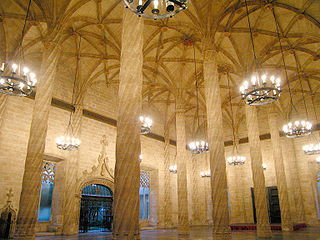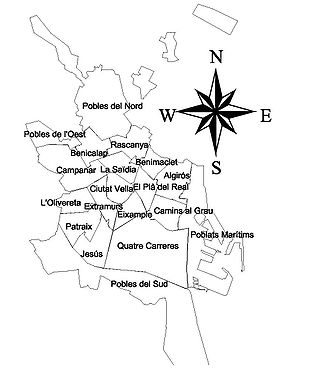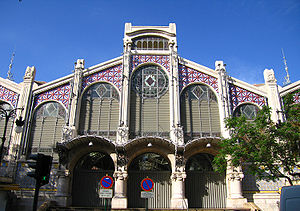
Valencia is the capital of the province and autonomous community of the same name in Spain. It is the third-most populated municipality in the country, with 807,693 inhabitants within the commune, 1,582,387 inhabitants within the urban area and 2,522,383 inhabitants within the metropolitan region. It is located on the banks of the Turia, on the east coast of the Iberian Peninsula on the Mediterranean Sea.

The Lonja de la Seda is a late Valencian Gothic-style civil building in Valencia, Spain. It is a principal tourist attraction in the city.

Spanish architecture refers to architecture in any area of what is now Spain, and by Spanish architects worldwide. The term includes buildings which were constructed within the current borders of Spain prior to its existence as a nation, when the land was called Iberia, Hispania, or was divided between several Christian and Muslim kingdoms. Spanish architecture demonstrates great historical and geographical diversity, depending on the historical period. It developed along similar lines as other architectural styles around the Mediterranean and from Central and Northern Europe, although some Spanish constructions are unique.

Valencia Cathedral, at greater length the Metropolitan Cathedral–Basilica of the Assumption of Our Lady of Valencia, also known as St Mary's Cathedral, is a Catholic church in Valencia, Spain.

The Mosque of Cristo de la Luz is a Catholic chapel and former mosque in Toledo, Spain. It is the one of the ten that existed in the city during the Moorish period. The edifice was then known as Mezquita Bab-al-Mardum, deriving its name from the city gate Bab al-Mardum. It is located near the Puerta del Sol, in an area of the city once called Medina where wealthy Muslims used to live.

Portuguese architecture refers to both the architecture of Portugal's modern-day territory in Continental Portugal, the Azores and Madeira, as well as the architectural heritage/patrimony of Portuguese architects and styles throughout the world, particularly in countries formerly part of the Portuguese Empire.

Spanish Gothic architecture is the style of architecture prevalent in Spain in the Late Medieval period.
The architecture of Mumbai blends Gothic, Victorian, Art Deco, Indo-Saracenic & Contemporary architectural styles. Many buildings, structures and historical monuments remain from the colonial era. Mumbai, after Miami, has the second largest number of Art Deco buildings in the world.

Orihuela Cathedral is the main Roman Catholic church of Orihuela, Valencian Community, southern Spain.

Pere Comte was a catalan architect from Girona. He was one of the main Gothic architects of the Crown of Aragon of the period, and in particular in Valencia, where he directed the construction of numerous palaces. Pere Compte is considered a master of the Valencian Gothic art.

The Church of Sant Nicolau de Bari and Sant Pere Màrtir is a Valencian Gothic style, Catholic parish church located in Valencia, Spain.

The Monastery of Santa María de Aguas Vivas, located in the municipality of Carcaixent (Valencia), Spain, is a religious building dating back to the 13th century.

The Eixample or Ensanche is a district of Valencia, Spain between the Old City, Quatre Carreres, Camins al Grau, Extramurs and El Pla del Real. This area takes in the city's most popular shopping street on carrer Colón, Marqués del Túria Avenue and Russafa. It is also the most important commercial area, where popular department stores and shops are located. Moreover, it is very close to important points like the Colón Market, the City Hall, Pau street, etc. It also has excellent public transport communication.

Valencian Gothic is an architectural style. It occurred under the Kingdom of Valencia between the 13th and 15th centuries, which places it at the end of the European Gothic period and at the beginning of the Renaissance. The term "Valencian Gothic" is confined to the Kingdom of Valencia and its area of influence, which has its own characteristics.

The Church of Santos Juanes or Sant Joan del Mercat is a Catholic church located in the Mercat neighborhood of the city of Valencia, Spain. The church is also denominated the Real Parroquia de los Santos Juanes or San Juan del Mercado due to its location adjacent to the city Central Market and facing the Llotja de la Seda building.

Art Nouveau in Alcoy, as one of the main focuses of the Valencian Art Nouveau, is the historiographic denomination given to an art and literature movement associated with the Art Nouveau in Alcoy (Alicante), Valencian Community, in Spain.

Valencian Art Nouveau is the historiographic denomination given to an art and literature movement associated with the Art Nouveau in the Valencian Community, in Spain.

Mercado de Colón or Valencian: Mercat de Colom is a public market located in the city center of Valencia, Spain. It is one of the main works of the Valencian Art Nouveau.

The Casa Laporta(Laporta house) is a private building at 26 País Valencià avenue, in the city center of Alcoy (Alicante), Valencian Community, Spain. It is one of the main works of the Art Nouveau in Alcoy.
This is an alphabetical index of articles related to architecture.



















